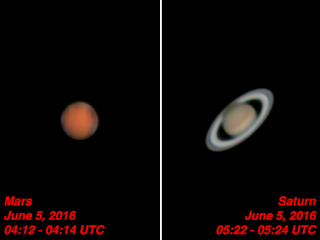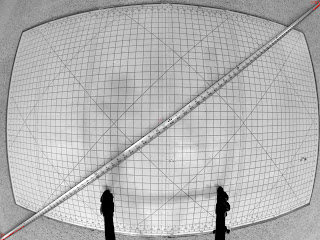Mars and Saturn near opposition
Mars was at opposition (directly opposite the Sun from the Earth) on May 22, and Saturn was at opposition on June 2. I've been itching to get some photos of them, and the combination of clear skies, reasonably good seeing (low upper-atmosphere turbulence) and time available made last night a good choice. Without further ado, the photos:
Although the photos say "June 5" I took them the night of June 4, local time, at about 10:12 PM and about 11:22 PM Mountain Daylight Time, from our back yard in Fort Collins, Colorado.
My equipment was a Meade LX90 ACF 8" f/10 Schmidt-Cassegrain telescope mounted on an iOptron CEM-60. The camera was a ZWO ASI174MM monochrome camera, with an RGB filter wheel and a 2.4x Barlow, which made the combo a 4800mm focal length f/24 system.
Mars was taken with a 1.9ms shutter and a gain of 280 in FireCapture. It was a 640x480 ROI, running at 182 FPS. Saturn was taken with a 6.89ms shutter and a gain of 351, also a 640x480 ROI, but a lower FPS at 121.
Both images are stacks of the best 500 out of 1000 of each of red, green, and blue, stacked with Autostakkert 2.6.6, with a drizzle of 1.5x (which made the net size of the image 960x720). Before stacking, I normalized the brightness in Photoshop. On Mars, I brightened red by 3x, green by 2x, and blue by 4x. On Saturn, I brightened red by 6x, green by 4x, and blue by 8x. This was to make it easier for Autostakkert to align (and easier for me to pick alignment points!). On Mars, I aligned on the planet center. On Saturn, I aligned on the planet center as well on the extrema of Cassini's division at the upper right and lower left.
After stacking, I brought the resulting R, G, and B images back into Photoshop. I sharpened them up with its Smart Sharpen filter with a 7.5 pixel diameter, assigned the proper channels, then tweaked the final brightness and saturation for a pleasing image.
Just for fun, here is a raw green image of Saturn, along with a stacked green image of Saturn, to demonstrate how much processing goes into these results. First, the raw green image (one of 1000 such images):
Next, the stacked green image:
Finally, the same for Mars. A raw green image:
Some day I should try this from someplace not directly down-wind of the turbulence-inducing Rocky Mountains.
Although the photos say "June 5" I took them the night of June 4, local time, at about 10:12 PM and about 11:22 PM Mountain Daylight Time, from our back yard in Fort Collins, Colorado.
My equipment was a Meade LX90 ACF 8" f/10 Schmidt-Cassegrain telescope mounted on an iOptron CEM-60. The camera was a ZWO ASI174MM monochrome camera, with an RGB filter wheel and a 2.4x Barlow, which made the combo a 4800mm focal length f/24 system.
Mars was taken with a 1.9ms shutter and a gain of 280 in FireCapture. It was a 640x480 ROI, running at 182 FPS. Saturn was taken with a 6.89ms shutter and a gain of 351, also a 640x480 ROI, but a lower FPS at 121.
Both images are stacks of the best 500 out of 1000 of each of red, green, and blue, stacked with Autostakkert 2.6.6, with a drizzle of 1.5x (which made the net size of the image 960x720). Before stacking, I normalized the brightness in Photoshop. On Mars, I brightened red by 3x, green by 2x, and blue by 4x. On Saturn, I brightened red by 6x, green by 4x, and blue by 8x. This was to make it easier for Autostakkert to align (and easier for me to pick alignment points!). On Mars, I aligned on the planet center. On Saturn, I aligned on the planet center as well on the extrema of Cassini's division at the upper right and lower left.
After stacking, I brought the resulting R, G, and B images back into Photoshop. I sharpened them up with its Smart Sharpen filter with a 7.5 pixel diameter, assigned the proper channels, then tweaked the final brightness and saturation for a pleasing image.
Just for fun, here is a raw green image of Saturn, along with a stacked green image of Saturn, to demonstrate how much processing goes into these results. First, the raw green image (one of 1000 such images):
Next, the stacked green image:
Finally, the same for Mars. A raw green image:
And the stacked green image:
Some day I should try this from someplace not directly down-wind of the turbulence-inducing Rocky Mountains.






Comments